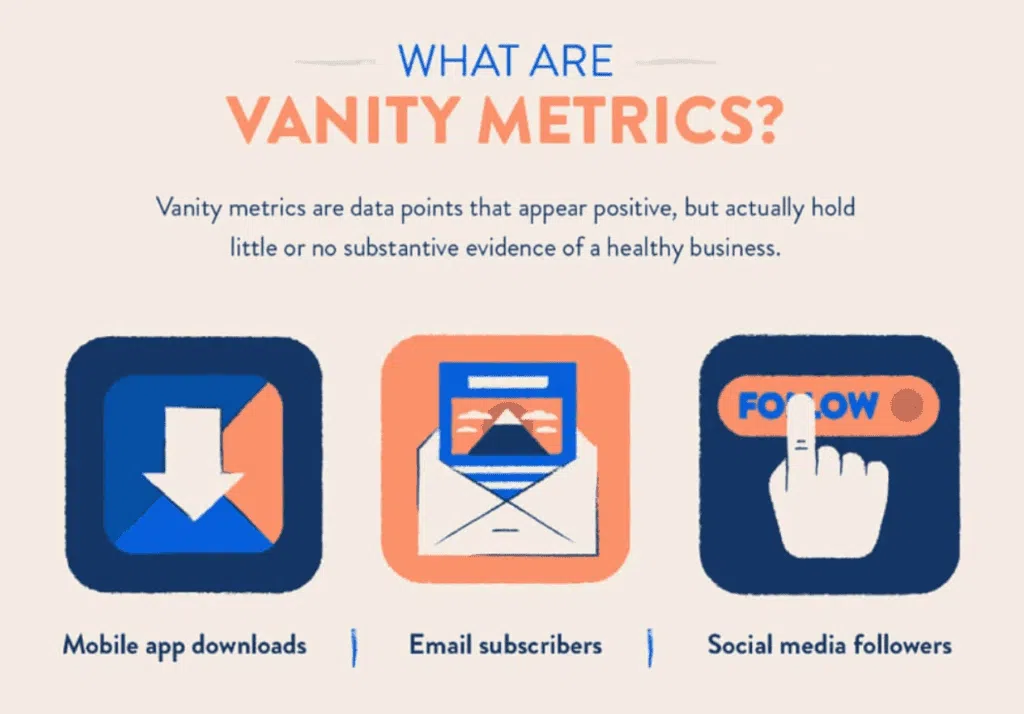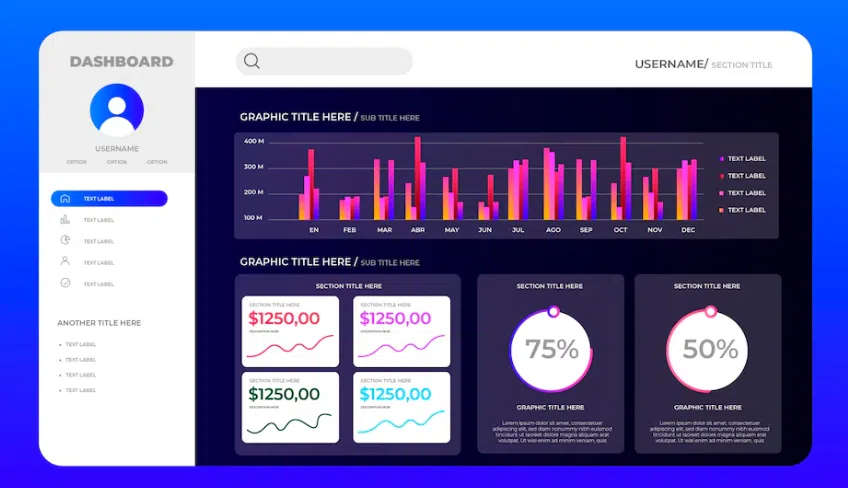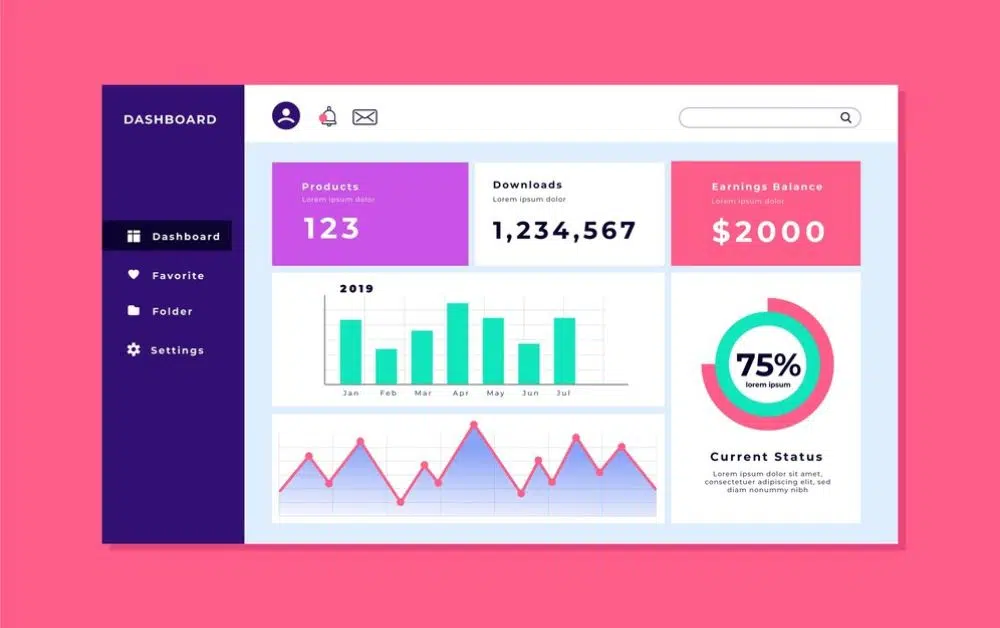Social media has become significant in our lives in the modern digital age. If you’re a social media user, a business owner, or just someone who enjoys sharing pictures with pals, you’ve undoubtedly noticed all the stats associated with social media. Views, likes, and following can all be fascinating to observe. When they rise, they have the power to uplift us. But do these figures matter as much as they seem to?
This blog article will discuss “vanity metrics” on social media. If you’re unfamiliar with this word, don’t worry; we’ll break everything down for you. After reading this article, you’ll know what vanity metrics are, why their use may be underestimated, and what you should look at instead.
Table of Contents
ToggleWhat Are Vanity Metrics?
Let’s start by breaking down what we mean by saying “vanity metrics.”
Definition of Vanity Metrics
Vanity metrics are numbers on social media that might look impressive at first glance but keep you a secret about how well you’re doing. They’re called “vanity” metrics because they can make you feel good about yourself or your business, like looking in a mirror and liking what you see. However, just like a mirror only shows the surface, these metrics only show a small part of the picture.
Common Examples of Vanity Metrics
Here are some numbers that are often considered vanity metrics:
- Number of followers
- Likes on a post
- Views on a video
- Page visits
- Number of downloads
These numbers can be fun to watch, and wanting them to go up is natural. But as we’ll see, they sometimes mean something other than what we think they mean.
Why People Focus on Vanity Metrics
There are a few reasons why people often pay a lot of attention to these numbers:
- They’re easy to see and understand
- They can make us feel good when they increase
- We might think they show how popular or successful we are
- Sometimes, we believe having high numbers will impress others
The Problem with Vanity Metrics
Now that we know what vanity metrics are let’s talk about why they might not be as helpful as we think.
They Don’t Show the Whole Picture
Imagine you have a lemonade stand. You might count how many people walk by your stand and think that’s a good measure of your performance. But what if most of those people don’t buy any lemonade? Just counting passersby only tells you a little about your actual sales.
It’s the same with vanity metrics. Having a lot of followers doesn’t mean those followers are interested in what you’re sharing. Getting many likes on a post doesn’t necessarily mean people found it helpful or remembered it later.
They Can Be Misleading
Sometimes, vanity metrics can give us the wrong idea about how we’re doing. For example:
- You might have 10,000 followers, but if only 100 of them regularly engage with your content, that significant number is less impressive than it seems.
- A video might get a million views, but it might have little impact if most people only watched the first few seconds.
- Your website might get many visitors, but those visits aren’t precious if they leave immediately without doing anything.
They Don’t Always Lead to Real Results
The ultimate goal for businesses and content creators is to achieve something specific – like making sales, getting newsletter sign-ups, or spreading an important message. Vanity metrics only sometimes help with these goals.
For instance, having a million followers only helps if none of those followers ever buy your products or share your content with others.
Examples of Vanity Metrics in Different Social Media Platforms
Let’s look at some specific examples of vanity metrics on different social media platforms. Remember, these are sometimes good to look at, but they should be one of many things you pay attention to.

Facebook Vanity Metrics
- Page likes The number of people who have liked your Facebook page.
- Post reach: How many people supposedly saw your post in their feed?
- Video views: The number of times your video was played, even for a few seconds.
Instagram Vanity Metrics
- Follower count: The total number of accounts following you on instagram.
- Likes on posts: How many people tapped the heart icon on your photo or video?
- Comments: The number of comments on a post (even if they’re just emojis or very short).
Twitter Vanity Metrics
- Number of followers: How many accounts are following you?
- Retweets: How many times have others shared your tweet?
- Impressions: The number of times your tweet appeared in someone’s timeline.
YouTube Vanity Metrics
- Subscriber count: The number of people subscribed to your channel.
- View count: How many times has your video been played?
- Likes: The number of thumbs-ups on your video.
LinkedIn Vanity Metrics
- Connection count: The number of people in your network.
- Post Views: How many times did your post supposedly appear in others’ feeds?
- Profile views: How many times have people looked at your profile?

Why Vanity Metrics Can Be Harmful
Now that we’ve seen examples of vanity metrics let’s talk about why focusing too much on them can be bad for you or your business.
They Can Lead to Poor Decision Making
When we pay too much attention to vanity metrics, we might make choices that could be better for us in the long run. For example:
- A business might spend a lot of money on ads to get more followers, even if those followers never become customers.
- A content creator might change their style to get more likes, even if it means their content isn’t as helpful or accurate to their goals.
- Someone might need more time trying to increase their follower count instead of focusing on creating quality content.
They Can Hurt Your Mental Health
Constantly checking likes, followers, and views can be stressful. It can make you feel like you’re continually competing with others or that your worth is tied to these numbers. This isn’t healthy, and it can lead to:
- Anxiety about posting content
- Feeling bad about yourself if the numbers don’t go up
- Comparing yourself to others in an unhealthy way
- Spending too much time on social media, which can affect other parts of your life
They Can Distract You from What Matters
You might miss out on more important things when you’re always thinking about vanity metrics. For instance:
- You might not notice that your small but loyal audience loves your content.
- You could overlook opportunities to connect more deeply with your followers.
- You might need to remember your original goals and why you started using social media in the first place.
What to Focus on Instead: Actionable Metrics
If vanity metrics aren’t that useful, what should we be looking at instead? The answer is something called “actionable metrics.” These numbers tell you something valuable and can help you make good decisions.
What Are Actionable Metrics?
Actionable metrics are numbers that:
- Show how well you’re achieving your goals.
- Help you understand what’s working and what’s not.
- Give you information you can use to make things better.
Unlike vanity metrics, which make you feel good (or bad), actionable metrics help you take action to improve.
Examples of Actionable Metrics
Here are some examples of actionable metrics that can be more useful than vanity metrics:
- Engagement rate: This shows how many followers interact with your content. It’s more valuable than just looking at follower count.
- Conversion rate: This measures how many people take a specific action you want, like signing up for a newsletter or buying a product. It’s more important than just counting page views.
- Retention rate: This shows how many people return to your content or platform. It’s more valuable than just counting new followers.
- The click-through rate measures how many people click on a link in your post. It’s more valuable than looking at how many people saw the post.
- Time spent on content: This shows how long people read your blog post or watch your video. It’s more meaningful than just counting views.
How to Use Actionable Metrics
Here are some tips for using actionable metrics effectively:
- Set clear goals: Know what you want to achieve with your social media presence.
- Choose metrics aligning with your goals: To build a community, look at engagement rates. If you’re trying to sell products, focus on conversion rates.
- Track changes over time: Don’t just look at the numbers once. See how they change and try to understand why.
- Use the information to make improvements: If a specific type of content gets more engagement, try creating more of that kind of content.
- Pay attention to qualitative data: Sometimes, reading comments and messages from your audience can give you insights that numbers alone can’t.
How to Move Away from Vanity Metrics
Changing your focus from vanity metrics to more useful ones can take time and effort. Here are some steps you can take to make this shift:
Identify Your True Goals
Before focusing on the right metrics, you must know what you’re trying to achieve. Ask yourself:
- Why am I on social media?
- What do I want to accomplish?
- How will I know if I’m successful?
Your goals might be building a community, spreading awareness about a cause, selling products, or doing something else entirely. Once you know your goals, you can choose metrics that help you reach them.
Choose the Right Tools
Many social media platforms offer analytics tools that can help you track more valuable metrics. Some popular options include:
- Facebook Insights
- Instagram Insights
- Twitter Analytics
- YouTube Analytics
- Google Analytics (for websites)
These tools can provide more detailed information about your audience and how they interact with your content.
Educate Your Team or Clients
If you work with others on your social media strategy, ensuring everyone understands why you’re shifting away from vanity metrics is essential. Explain:
- What vanity metrics are and why they can be misleading
- Which actionable metrics you’ll be focusing on instead
- How these new metrics will help you achieve your goals
This can help prevent misunderstandings and ensure everyone works towards the same objectives.
Set Realistic Expectations
Remember, moving away from vanity metrics might mean seeing smaller numbers at first. That’s okay! It’s better to have 100 engaged followers who love your content than 10,000 followers who never interact with you. Be patient and focus on building genuine connections and value.
The Role of Vanity Metrics in Social Media Strategy
While we’ve talked a lot about why vanity metrics can be problematic, it’s important to note that they’re only partially functional. If used correctly, they can still play a role in your social media strategy.
When Vanity Metrics Can Be Useful
There are times when vanity metrics can provide some value:
- Initial growth tracking: When you’re just starting, seeing your follower count grow can motivate and show that you’re gaining traction.
- Broad trends: While individual posts’ likes might not mean much, looking at likes over time can show you if your content is generally becoming more or less popular.
- Social proof: Having many followers or views can make others more likely to check out your content.
- Platform algorithms: Some social media platforms promote content that gets a lot of likes or views, so these metrics can indirectly help with visibility.
Balancing Vanity Metrics with Actionable Metrics
The key is to use vanity metrics as just one part of a larger strategy. Here’s how you can balance them with more actionable metrics:
- Look at vanity metrics for general trends, but take your time with them.
- Use actionable metrics to make decisions about your content and strategy.
- Consider how vanity metrics and actionable metrics work together. For example, if you have a lot of followers but low engagement, that tells you something important about your audience.
- Remember that different metrics matter more to varying stages of growth.
Communicating About Metrics
When discussing your social media performance with others (like bosses, clients, or team members), it’s essential to put metrics in context. Here are some tips:
- Explain what each metric means and why it’s important (or not essential).
- Show how different metrics relate to each other and your overall goals.
- Use stories and examples to illustrate what the numbers mean in real terms.
- Be honest about both successes and areas for improvement.
The Future of Social Media Metrics
As social media continues to evolve, how we measure success on these platforms will likely change, too. Let’s look at some trends that might shape the future of social media metrics.
Increased Focus on Quality Over Quantity
Many experts predict that in the future, social media platforms and users will care more about the quality of interactions rather than just the number of likes or followers. This might mean:
- New metrics that measure how meaningful interactions are
- Less emphasis on publicly visible numbers like follower counts
- More tools to measure long-term impact rather than just immediate reactions
Greater Privacy Concerns
People are becoming more aware of online privacy issues that could affect how metrics are collected and shared. We might see:
- Less detailed data available about individual users
- More aggregated or anonymized data
- New metrics that respect user privacy while still providing valuable insights
Artificial Intelligence and Advanced Analytics
As AI technology improves, we’ll likely see more sophisticated ways of analyzing social media data. This could include:
- Better prediction of which content will perform well
- More accurate identification of fake followers or engagement
- Advanced sentiment analysis to understand how people feel about content
Integration with Other Data Sources
Social media metrics might be combined with other data types to give a more complete picture. This could involve:
- Connecting social media activity to real-world actions (like store visits or purchases)
- Combining social media data with other online behaviour data
- Integrating social media metrics with broader business analytics
Conclusion: Finding the Right Balance
We’ve covered a lot of ground in this post about vanity metrics in social media. Let’s recap the main points:
- Vanity metrics are numbers that look impressive but only sometimes tell you much about your actual success.
- Standard vanity metrics include follower counts, likes, and view numbers.
- While these metrics can be exciting to watch, they can also be misleading and even harmful if you focus on them too much.
- Instead of vanity metrics, it’s better to focus on actionable metrics that help you understand and improve your performance.
- Moving away from vanity metrics involves setting clear goals, choosing the right tools, and educating yourself and others about what matters.
- Vanity metrics are only partially functional but should be a small part of measuring your social media success.
- The future of social media metrics will likely involve more focus on quality, privacy, and sophisticated analysis.
The key takeaway is that while it’s natural to care about numbers like followers and likes, these should be something other than your primary focus. Instead, think about what you want to achieve with your social media presence. Choose metrics that help you reach those goals and improve your content.
Remember, social media is ultimately about connecting with people and sharing things that matter to you. If you’re doing that successfully, the correct numbers will follow. Don’t let the pursuit of vanity metrics distract you from creating genuine connections and valuable content.
By understanding the difference between vanity and actionable metrics, you can use social media more effectively and enjoy it more. Whether you’re using social media for business or personal reasons, focusing on what matters will help you get the most out of your online presence.
Here are 5 FAQs about vanity metrics for social media:
What are vanity metrics in social media?
Vanity metrics are surface-level measurements on social media platforms that may look impressive but don’t necessarily indicate real engagement or business value. Examples include follower count, likes, and video views. While these numbers can be attention-grabbing, they often don’t reflect meaningful interactions or contribute directly to your goals.
Why are vanity metrics called “vanity” metrics?
They’re called vanity metrics because they can make you feel good about your social media presence (like looking in a mirror and liking what you see). Still, they sometimes provide actionable insights or correlate with actual success. The term suggests that focusing on these metrics might be more about ego than achieving real business or communication objectives.
Are all easily measurable metrics considered vanity metrics?
No, not all easily measurable metrics are vanity metrics. The critical difference is whether the metric provides actionable insights that can help improve your strategy or achieve your goals. For example, while ‘number of followers’ might be a vanity metric, ‘engagement rate’ (which measures how many of your followers interact with your content) can be a more meaningful metric, empowering you to make informed decisions about your social media strategy.
Should I ignore vanity metrics entirely?
While you shouldn’t focus solely on vanity metrics, they’re not entirely useless. They can quickly overview your social media growth and sometimes indicate broader trends. The key is using them with more meaningful, actionable metrics rather than relying on them exclusively.
What should I focus on instead of vanity metrics?
Instead of vanity metrics, focus on actionable metrics that align with your goals. These might include engagement rate, conversion rate, click-through rate, or customer lifetime value. Also, pay attention to qualitative data like the sentiment of comments and the quality of interactions with your audience. By focusing on these actionable metrics, you can feel reassured that you’re making informed decisions and confident in your social media strategy. The most valuable metrics will depend on your specific objectives for using social media.

Mohamed Adil, is a versatile blogger specializing in social media tips, bios, Shayari, guides, and informative content. With a keen eye for detail and a passion for writing, Adbuay offers valuable insights and engaging articles that cater to a diverse audience. Stay tuned for practical advice and creative inspiration from this talented author.

